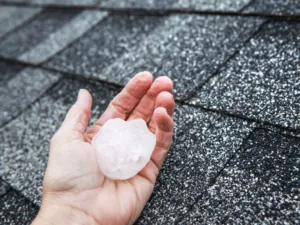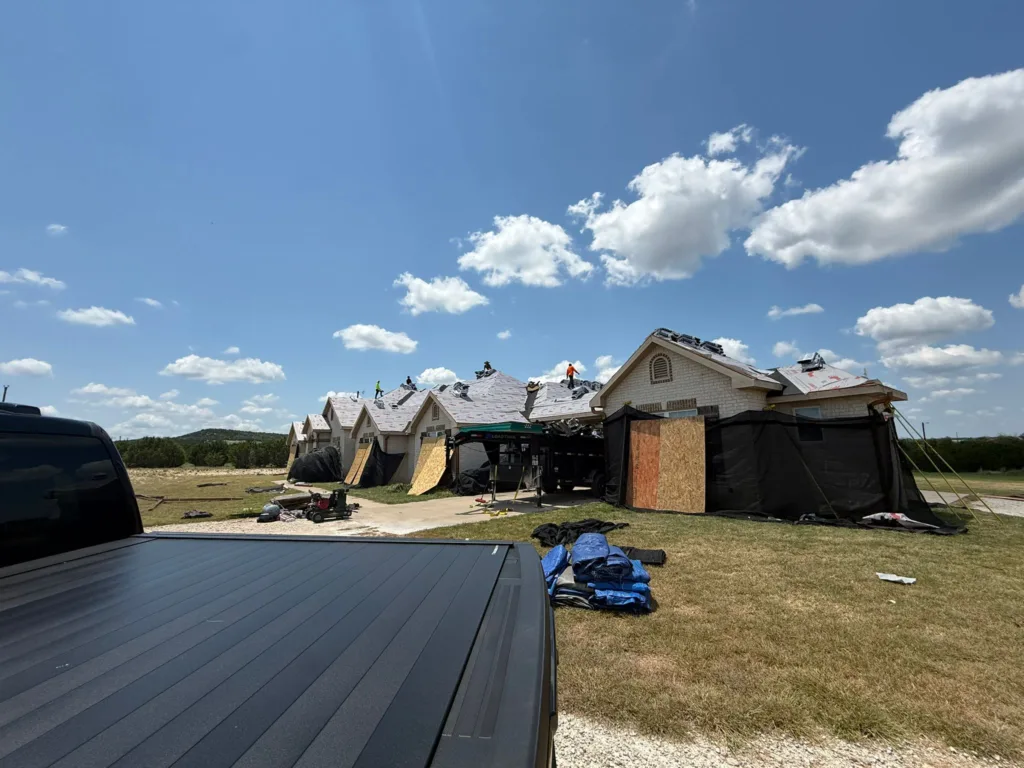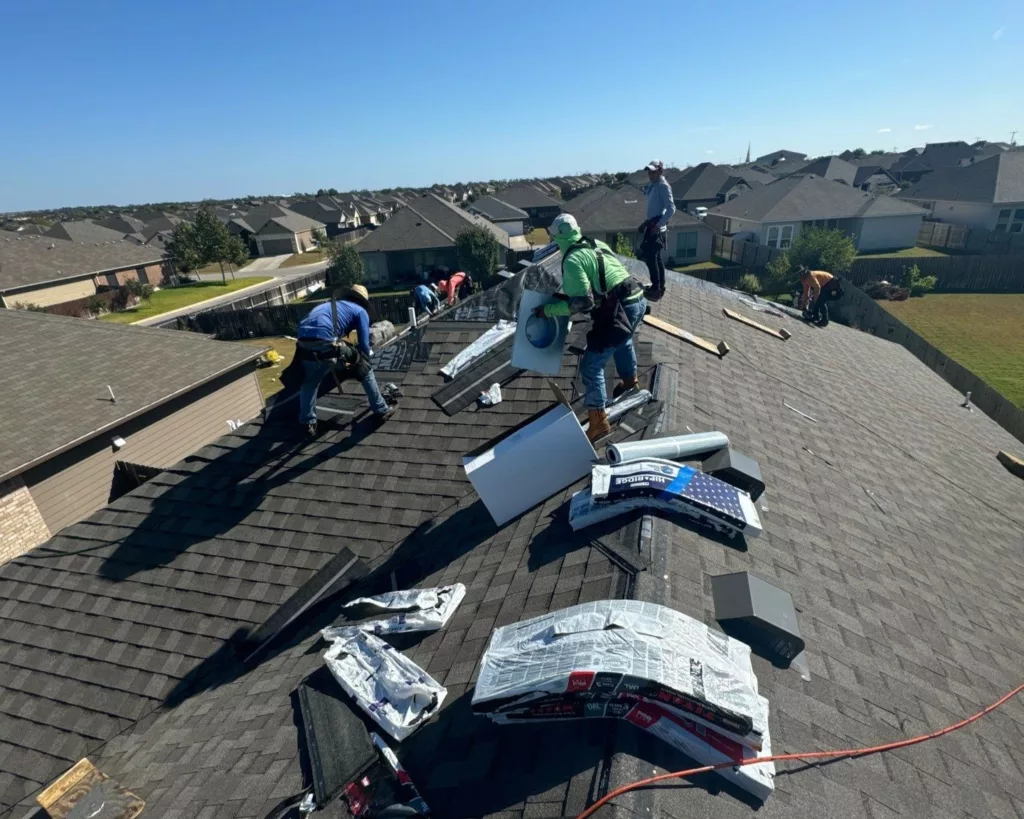
Monday to Friday
Drop your queries
Menu
Monday to Friday
Drop your queries

A roof rarely fails all at once. Most of the time, it starts with signs homeowners tend to brush off — a few missing shingles, slight discoloration, or an occasional leak after a storm. But in Texas, those small red flags can quickly snowball into major roof damage.
Across cities like Austin, Round Rock, and Leander, roofs are exposed to scorching heat, powerful hailstorms, and sudden downpours that test their durability year-round. These harsh conditions can dramatically shorten the lifespan of your roofing system, especially if it’s already aging or poorly maintained.
In fact, most asphalt shingle roofs in Texas last only 12 to 15 years, compared to the national average of 20 to 25 years. That’s because the UV exposure, heat cycles, and severe weather events common across the state accelerate wear much faster than most homeowners expect.
Knowing when to replace your roof is more than just a matter of timing — it’s about protecting your property before small issues turn into costly damage. If your home has weathered several Texas storm seasons, or if you’re unsure how old your roof really is, now is the time to take a closer look.
Roofs in Texas don’t get much of a break. The state’s climate swings from blazing heat to violent hailstorms, often within the same season. Over time, these weather extremes take a serious toll on even the most well-built roofing systems.
In cities like Dripping Springs and Lakeway, prolonged sun exposure causes shingles to dry out, fade, and crack. The constant heat expansion and contraction can loosen materials and create gaps where moisture can enter.
Up north in Frisco, Dallas, and Georgetown, large hail and high-speed winds are more common. These conditions knock granules loose from asphalt shingles and dent flashing or vents, weakening the roof’s protective surface. Once those outer layers are compromised, leaks become much more likely — especially during storm season.
Even coastal and Central Texas areas like San Antonio and Bee Cave are no strangers to heavy rainfall and wind-driven storms. Water can get forced under shingles or flashing and penetrate beneath the surface, leading to rot, mold, or structural issues if it isn’t addressed quickly.
According to recent insurance data, Texas recorded over 878 major hail events in 2024 alone, more than any other state. That much activity means nearly every home in the state has some risk of damage — even if you haven’t noticed any leaks yet.
Because of the unique climate challenges across Texas, a roof that might last 25 years elsewhere may only hold up for 12 to 15 years here. Without regular inspections and timely repairs or replacement, it’s easy for homeowners to fall behind on needed roof maintenance until it’s too late.
Not every roofing problem calls for a full replacement, but certain signs suggest your current roof is nearing the end of its service life. Catching these indicators early can help you avoid unexpected damage, denied insurance claims, or rushed emergency work after a storm.
Below are some of the most common warning signs Texas homeowners should watch for:
1. Your Roof Is 12 to 15 Years Old
In Texas, that’s often the tipping point for asphalt shingles. UV exposure, hail, and thermal expansion cause faster deterioration. If your roof is within this age range and hasn’t been replaced or inspected recently, it may already be at risk.
2. Missing or Curling Shingles
Shingles that are cracked, curled, or entirely missing create weak spots. This allows water, pests, and debris to enter the roof system. Texas winds and hail make this kind of damage especially common after spring and summer storms.
3. Frequent Leaks or Ceiling Stains
A single leak might be repairable, but recurring ceiling stains, especially in different parts of the home, can indicate widespread damage to the underlayment or decking. Persistent leaks are often a sign it’s time for a new roof.
4. Sagging Areas or Uneven Roof Lines
This may point to structural damage, waterlogged decking, or shifting due to repeated storm stress. If the roof appears wavy or drooping, it needs immediate evaluation to avoid further risk.
5. Granules in Your Gutters or Around Downspouts
Granules protect shingles from UV damage. If you’re seeing large amounts of them in your gutters, the shingles are likely breaking down. This makes the roof more vulnerable to leaks and heat damage.
6. Rising Energy Bills
Poor roof insulation or hidden gaps can allow conditioned air to escape, making your HVAC system work harder. If your bills have gone up and other factors haven’t changed, the roof could be the issue.
7. Your Neighbors Are Getting New Roofs
Many homes in Texas neighborhoods are built around the same time. If neighbors in your area — like Horseshoe Bay, Cedar Park, or Leander — are replacing their roofs, yours may not be far behind.

Delaying a roof replacement can feel like a cost-saving decision in the short term, but for many Texas homeowners, it leads to far greater expenses down the road. A worn-out roof doesn’t always show obvious signs of failure — until damage has already spread beneath the surface.
Here’s what can happen when you put off a needed replacement:
Interior Damage from Leaks
What starts as a minor drip can quickly escalate into soaked insulation, stained ceilings, warped drywall, and mold. In cities like Round Rock or New Braunfels, where storms can dump inches of rain in a matter of hours, even a small roof breach can cause thousands in interior repairs.
Rotting Roof Decking and Structural Issues
Old shingles and damaged flashing allow water to reach the wood beneath. Over time, the roof decking can rot, rafters can weaken, and the overall structure may sag. Replacing framing or decking significantly increases the cost — sometimes requiring a full tear-off.
Mold Growth in the Attic or Walls
Texas humidity, combined with roof leaks, creates the perfect environment for mold. Once mold spreads, remediation can cost anywhere from $2,000 to $6,000, depending on how far it reaches behind walls or into insulation.
Insurance Claim Denials
Texas insurance companies are tightening their claim requirements. If you delay replacing an obviously failing roof, your insurer may argue that the resulting damage was preventable — and deny your claim altogether.
Emergency Costs After a Storm
Waiting too long often means discovering the problem after a storm has already done its damage. Emergency tarping, rush repairs, and short-notice contractor bookings cost more than a planned, timely replacement.
In Texas cities where hail and heavy rain are part of the seasonal norm, waiting too long to replace a roof is a gamble. The longer the delay, the more likely the damage spreads — and the higher the cost to fix it.
For many Texas homeowners, roof replacement feels like an overwhelming project — especially if it’s their first time. But with the right contractor and a clear plan, the process is more manageable than most expect.
Here’s a step-by-step look at what happens during a typical roof replacement:
1. Initial Inspection and Estimate
A roofing specialist assesses the condition of your current roof, identifying issues like structural damage, worn materials, or signs of hail impact. In cities like Bee Cave or Fredericksburg, this inspection also takes into account local building codes, HOA requirements, and storm history.
2. Material Selection and Planning
You’ll choose roofing materials that fit your style, budget, and performance needs. Homeowners in Boerne often choose energy-efficient options to help offset the summer heat, while those in The Woodlands may prefer Class 4 impact-resistant shingles due to frequent hail.
3. Scheduling and Permits
Once materials are selected and the estimate is approved, the contractor will pull necessary permits and schedule your project. This includes coordinating delivery of materials, setting up protective coverings for landscaping, and finalizing logistics.
4. Roof Tear-Off and Surface Prep
The old roofing system is removed down to the decking. Any damaged decking is replaced, and underlayment is installed to serve as a secondary water barrier. Contractors will also ensure proper ventilation and flashing details are updated.
5. Installation of New Roofing System
Shingles, tiles, or other materials are installed according to manufacturer guidelines and local code. Areas around chimneys, vents, and valleys receive extra attention for waterproofing.
6. Cleanup and Final Inspection
Professional crews use tools like magnetic rollers to collect nails and debris. The roofing contractor performs a thorough final inspection to ensure everything was installed correctly and that your property is clean and safe.
7. Documentation and Warranty
You’ll receive documentation for your warranty, photos of the completed work, and any paperwork needed for insurance or HOA records. In places like Cedar Park, this can be helpful for resale disclosures or long-term planning.
Roof replacement doesn’t have to be disruptive or confusing. When managed correctly, it’s a streamlined process that protects your home and adds long-term value.
Roof problems rarely improve on their own, especially in Texas where heat, hail, and harsh weather speed up wear and tear. If your roof is showing signs of age or damage—or if it’s simply been a while since your last inspection—now is the time to take a closer look. Replacing your roof before leaks, sagging, or structural problems appear can save you thousands of dollars and spare you the stress of emergency repairs.
At Legacy Roofing Pros, we make the process simple, honest, and pressure-free. Our experienced team provides thorough roof inspections, clear explanations, and customized replacement options based on your home’s needs and location. Whether you’re in The Woodlands, Boerne, Lakeway, or anywhere in between, we’re here to help you protect your home and investment.
Schedule your free roof inspection today and let’s find out if a replacement makes sense for you.
If you’ve noticed signs of roof wear or just want peace of mind, let us take a closer look. Our team offers free, no-obligation roof inspections anywhere in Texas—no pressure, just honest answers.
Book your free roof inspection today:
Most roofs in Texas last between 15 and 25 years, depending on the material and exposure to weather. Asphalt shingles tend to last closer to 15–20 years in areas with intense heat or frequent hail. Higher-end materials like polymer or metal may last 30–50 years.
For a standard asphalt shingle roof, costs typically range from $6,000 to $10,000. Premium systems like polymer slate or shake can range from $18,000 to $35,000 or more. Price depends on size, pitch, materials, and your location within Texas.
Insurance may cover your roof if the damage is caused by a covered event like hail or wind. It usually won’t cover wear and tear or neglect. That’s why it’s important to document roof condition and act quickly after a storm. A free inspection helps you understand what qualifies.
Yes. Roof replacements are noisy but typically safe for homeowners and pets to remain indoors. Most projects are completed within 1 to 3 days.
Consider the local climate, your budget, energy efficiency goals, and neighborhood requirements. Asphalt shingles are common, but synthetic options like DaVinci polymer roofing offer better impact resistance and longer warranties — ideal for hail-prone cities like Leander, Lake Travis, and Fredericksburg.
Spring and fall are ideal, with milder weather and fewer delays. However, in Texas, roofing can be done year-round. Just keep in mind that busy storm seasons may affect scheduling.
Look for curling or missing shingles, frequent leaks, sagging rooflines, or granules in gutters. If your roof is more than 15 years old and has seen multiple storms, it may be time to consider a replacement.
Most residential roof replacements take 1 to 3 days depending on size and complexity. Specialty materials may add a day or two to the timeline.
Yes. Many roofing companies, including Legacy Roofing Pros, offer financing options for qualified homeowners to help spread the cost of roof replacement over time.
Certified contractors like Legacy Roofing Pros meet manufacturer requirements for product installation, safety, and service. Certification often qualifies your roof for extended warranties and ensures it’s built to last in Texas conditions.
Legacy Roofing Pros is more than just a roofing company – we’re your trusted partner in safeguarding what matters most. That’s why we’re dedicated to providing top-tier roofing services that prioritize quality, reliability, and customer satisfaction